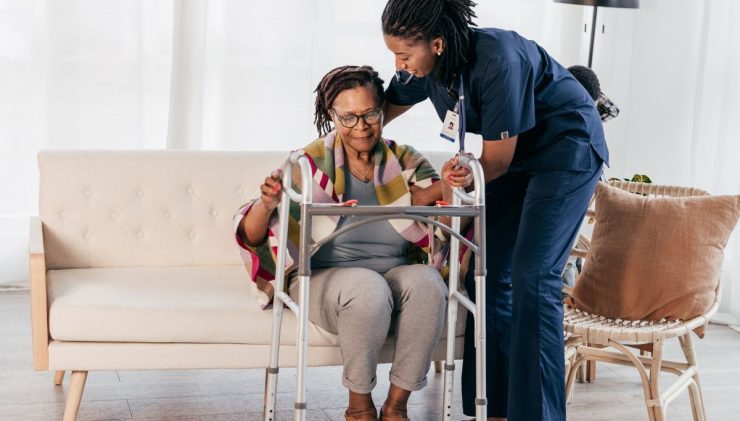 Conducting Home Risk Assessments
Conducting Home Risk AssessmentsYou can’t provide care to vulnerable populations without taking on some risk. Due to the very nature of the industry, senior living facilities have significant liability exposures. By learning about the frequent causes of senior living claims, operators can take steps to control their risks.
Fall-Related Injuries
The CDC says falls are the leading cause of injury and death among people aged 65 and above. Every year, 36 million older adults fall. Of these, 3 million are treated in the emergency room and 32,000 die as a result of injuries sustained.
According to the 11th Edition Aging Services Claim Report from CNA, resident falls are the most common cause of claims. The study looked at aging services liability claims with paid indemnity of at least $10,000 and found that 40.4% of closed claims were due to resident falls. In assisted living facilities, resident falls accounted for 54.8% of all closed claims.
Seniors who fall once have a higher risk of falling again. Therefore, if a resident falls, assisted living facilities should take extra precautions to prevent future falls. Failure to take these precautions could result in liability since facility operators are expected to know the risks. According to CNA, 59.7% of fall-related closed claims involved a resident who had experienced a previous fall – and these claims resulted in larger losses.
Senior living facilities can keep their residents safe and reduce their liability by being proactive about fall safety. It’s important to frequently review the following best practices with your team:
- Take precautions when transferring residents. As this is a particularly risky time, ensure you follow safety protocols.
- Monitor residents for fall risk. As a resident’s risk may increase over time – as a reaction to medication or due to an injury or illness – it’s important to conduct repeated risk assessments. Create and follow a care plan designed to reduce fall risks.
- Make sure your residents receive the care they need. For example, the CDC says it’s important for seniors to receive annual eyes checks. They should also have regular feet checks. An overlooked health issue could contribute to a fall.
- Offer activities that improve strength and balance. The right exercises can help seniors stay active and avoid falls. Consider offering exercise classes at your senior living facility.
- Educate your clients on postural hypotension. People with postural hypotension experience a drop in blood pressure when they stand up, which increases the risk of a fall. The CDC has a brochure on managing symptoms that you can share with your residents and their families.
- Watch your facility for tripping hazards. In addition to installing handrails, grab bars, proper lighting, and non-slip flooring, you need to stay alert for temporary hazards. For example, a torn carpet, broken tile, or misplaced electrical cord could contribute to a fall.
- The CDC offers additional resources through the Stopping Elderly Accidents, Deaths & Injuries (STEADI) initiative.
Inadequate Care
As you know, senior living facilities are expected to provide an adequate level of care. Failing to meet this duty is a major source of lawsuits. CNA says 13.9% percent of claims involved improper care (excluding falls), whereas 6.3% involved failure to monitor and 2.9% involved delays in seeking medical treatment.
Pressure injuries (or bedsores) are also a common cause of claims. CNA says 23.6% of claims involved pressure injuries, making this the second most common cause of claims after falls. The vast majority of pressure injury claims occur at skilled nursing facilities. However, more residents are choosing to age in place in assisted living facilities, which can contribute to an increased risk of pressure injury claims. In assisted living facilities, average losses from pressure injury-related claims have increased by more than 67% since 2018.
Even if the employees at a senior living facility care about their residents and want to keep them safe and healthy, inadequate care is a risk. For example, when facilities are dealing with staffing shortages, employees may cut corners or have insufficient time for care. A lack of training can also result in improper care – this is especially likely to be a problem for facilities with a high employee turnover rate. Problems can also occur when facility operators try to take on or keep residents they can’t adequately serve.
To reduce the incidence of claims, focus on your facility’s performance in these areas:
- Monitor residents for changes in their needs periodically and after injuries or illnesses.
- Transfer residents who need a higher level of care than your facility can provide. Even if residents don’t want to move to another facility, it may be necessary for their safety.
- Create clear and specific policies on when to seek medical care for residents.
- Train staff and require documentation to ensure your team follows all policies and procedures consistently.
You can avoid many senior living claims, but you still need a solid insurance program to manage your risks. We specialize in insurance for residential long-term care facilities for the elderly. Contact us to learn more.


